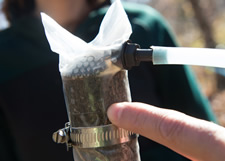A new way of producing maple syrup: "like a sugar-filled straw stuck in the ground"
 Interesting: Researchers at the University of Vermont's Proctor Maple Research Center -- Tim Perkins and Abby van den Berg -- have stumbled across a new, and potentially "revolutionary," way of harvesting sap for maple syrup. From a November 2013 UVM news article by Joshua E. Brown:
Interesting: Researchers at the University of Vermont's Proctor Maple Research Center -- Tim Perkins and Abby van den Berg -- have stumbled across a new, and potentially "revolutionary," way of harvesting sap for maple syrup. From a November 2013 UVM news article by Joshua E. Brown:
Their new technique uses tightly spaced plantations of chest-high sugar-maple saplings. These could be single stems with a portion -- or all -- of the crown removed. Or they could be multiple-stemmed maples, where one stem per tree can be cut each year. Either way, the cut stem is covered with a sealed plastic bag. Under the bag, the sap flows out of the stump under vacuum pressure and into a tube. Voilà , huge quantities of sap.
In short, these plantations can allow maple syrup production in a farm field.
Typically, a traditional sugarbush produces about 40 gallons of maple syrup per acre of forest by tapping, perhaps, 80 mature trees. With this new method, the UVM researchers estimate that producers could get more than 400 gallons of syrup per acre drawing from about 6,000 saplings. ...
"We got to the point where we should have exhausted any water that was in the tree, but the moisture didn't drop," says Perkins. "The only explanation was that we were pulling water out of the ground, right up through and out the stem." In other words, the cut tree works like a sugar-filled straw stuck in the ground. To get the maple sugar stored in the trunk, just apply suction.
Over at Modern Farmer this week, Laura Sorkin -- a maple producer in northern Vermont -- reflects on some of the possible implications of this new method, which could eventually offer cheaper production and protection against the effects of climate change and the Asian Longhorn Beetle. But also:
[T]he news of the plantation system has been a lot to chew on since we learned of it. We are relatively new to the trade but have come to love it, one of the principal reasons being our interaction with the thousand acres of forest behind our home. Like Dave Folino, I fear that the industry will no longer be special to New England but will be usurped by entrepreneurs anywhere with the right climate. And on a more visceral level, I feel that maple syrup is and should remain a product of the wild. Aside from mushrooms and game meat, the woods of Vermont hardly yield anything edible. And yet, this exquisite sugar can be extracted from the trees while still leaving them healthy and the forest a home to everything from rare wildflowers to bob cats. For me, knowing its origins elicits an amount of pleasure equal to tasting its unique flavor when I drizzle it over morning pancakes. Finally, I ponder what will happen to the acres of working forests if landowners are no longer making an income from them through tapping the trees. It would be unrealistic to expect all of those landowners to choose conservation.
Vermont is the country's leading producer of maple syrup -- it produced 1.32 million gallons of syrup in 2013. The #2 state? New York, at 574,000 gallons last year. [USDA]
photo: Sally McCay / UVM
[via Kottke]
Say Something!
We'd really like you to take part in the conversation here at All Over Albany. But we do have a few rules here. Don't worry, they're easy. The first: be kind. The second: treat everyone else with the same respect you'd like to see in return. Cool? Great, post away. Comments are moderated so it might take a little while for your comment to show up. Thanks for being patient.
Comments
I am slightly suspicious of this new method and wonder about it's potential negative side effects...
... said Pirate Jeni on Jan 23, 2014 at 10:36 AM | link